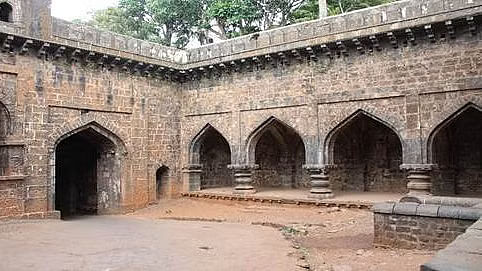
The Maratha Military Landscapes of India is the country's nomination for UNESCO World Heritage List.
Credit. X/@PIB_India
Raigad: In a step further to getting UNESCO World Heritage Site recognition for forts linked to the legendary Maratha warrior Chhatrapati Shivaji Maharaj, a team from the Paris-headquartered special United Nations’ agency visited the historic Raigad Fort and other forts.
The team also met Yuvraj Sambhaji Raje Chhatrapati of Kolhapur, the 13th descendent of Chhatrapati Shivaji Maharaj.
Sambhaji Raje is the Chairperson of the Raigad Development Authority (RDA), which over the past few years has been undertaking the restoration of the fort.
India has nominated “Maratha Military Landscapes of India” for recognition as UNESCO World Heritage List for the year 2024-25.
The twelve component parts of this nomination are, Salher Fort, Shivneri Fort, Lohgad Fort, Khanderi Fort, Raigad Fort, Rajgad Fort, Pratapgad Fort, Suvarnadurg Fort, Panhala Fort, Vijaydurg Fort, Sindhudurg Fort in Maharashtra and Gingee Fort in Tamil Nadu.
Most of these are linked to the life and times of Chhatrapati Shivaji Maharaj, the legendary Maratha warrior.
The Maratha Military Landscapes of India, which developed between the 17th and 19th centuries, represent an extraordinary fortification and military system envisioned by the Maratha rulers.
Chhatrapati Shivaji Maharaj (19 February 1630 – 3 April 1680) was coronated in Raigad Fort on 6 June, 1674 - and it is from here he laid the foundation of ‘Hindavi-Swarajya’ of self-rule of the Hindu-people.
As far as the nomination is concerned, the components, distributed across diverse geographical and physiographic regions, showcase the strategic military powers of the Maratha rule.
The Maratha Military Landscapes of India, which developed between the 17th and 19th centuries, represent an extraordinary fortification and military system envisioned by the Maratha rulers.
This extraordinary network of forts, varying in hierarchies, scales and typological features, is a result of integrating the landscape, terrain and physiographic characteristics distinctive to the Sahyadri mountain ranges, the Konkan Coast, Deccan Plateau and the Eastern Ghats in the Indian Peninsula.
There are more than 390 forts in Maharashtra out of which only 12 forts are selected under the Maratha Military Landscapes of India, of these eight forts are protected by the Archaeological Survey of India.